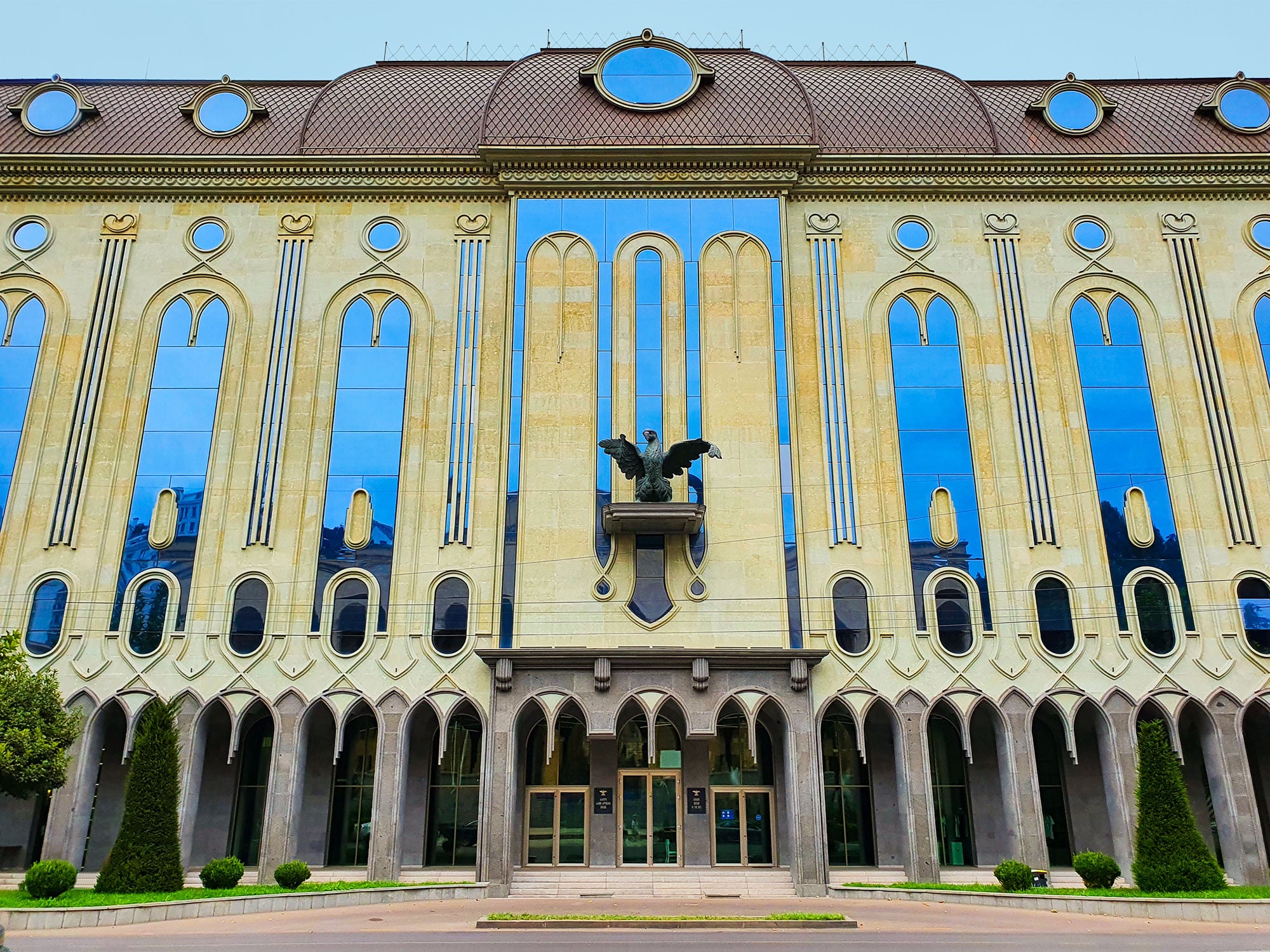Welcome to Tbilisi, a city of amazing history, breathtaking creativity, and constant innovation. Showcasing this are an astonishing number of great museums. This guide will take you through some of the city’s best institutions – from well-known staples like the National Museum of History to off-the-beaten-path gems like the Pirosmani House Museum, to often overlooked but fascinating finds like the Museum of Medicine. Exploring the museums of Tbilisi is an excellent way of exploring the rich history and culture of Georgia.
Art in Tbilisi
Georgian National Museum of Fine Arts
Founded in 1920, the Georgian National Museum of Fine Arts is home to an extensive collection of about 140,000 works that encompass Georgian, Eastern, Russian, and European art. The museum is particularly notable for its Georgian art collection, which traces the evolution of that culture’s national artistic expression over several centuries. Much of the other art helps to illustrate the influences over Georgian art through those same centuries. The museum’s oriental section is particularly impressive, with a notable array of Persian fine arts. The museum frequently hosts temporary exhibitions, drawing from its vast reserves and international collections, making it a dynamic hub for art lovers in Georgia. It is named for Shalva Amiranashvili, the Georgian art historian who assembled the museum’s first collection under the newly independent Democratic Republic of Georgia as it sought to assert its own identity after centuries of colonization.
Georgian Museum of Fine Arts
This centrally located museum offers a private collection of around 3,500 works by approximately 80 artists with the stated goal of popularizing modern Georgian fine art and inspiring modern Georgian artists. Here, you’ll find traditional and modern styles, a testament to the country’s evolving artistic landscape. The museum was started in 2018 by Gia Jokhtaberidze, one of Georgia’s wealthiest individuals, and Manana Shevardnadze, a film producer and daughter of former president Shevardnadze. Its collections are primarily composed of art privately held by the founders’ families.
The Zurab Tsereteli Museum of Modern Art
This private museum, situated on Shota Rustaveli Avenue, boasts a collection of around 300 pieces, including paintings, graphics, sculptures, and more. The pieces are almost all the work of Georgia’s world-renowned and controversial artist Zurab Tsereteli, who focuses on monumental, larger-than-life works. Established in 2012, it occupies the tsarist-era former building of the Tiflis Cadet Corps, which was beautifully restored on the initiative of Tsereteli. The museum’s layout is thoughtfully organized across three floors, providing an immersive experience into Tsereteli’s world and history.
The Dimitri Shevardnadze National Gallery
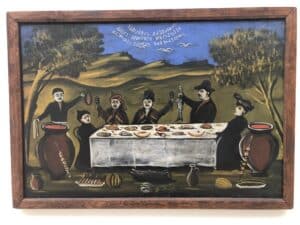
Part of the Georgian National Museum complex, The Dimitri Shevardnadze National Gallery holds a significant collection of over 30,000 items, focusing on contemporary Georgian art across various media including painting, sculpture, graphics, and decorative arts. The collection features works by renowned Georgian artists such as Elene Akhvlediani, David Kakabadze, Lado Gudiashvili, and many others. The Gallery’s original collection was founded through the vision of Dimitri Shevardnadze, another famed Georgian artist.
The Niko Pirosmani Museum
This museum celebrates the life and work of the renowned, self-taught Georgian painter. Visitors can explore Pirosmani’s highly expressive artworks, personal items, as well as learn more about his mostly poor, working-class life and rise to posthumous fame as a national symbol of his country. The museum explores Pirosmani’s unique artistic vision as well as the circumstances in which he worked. The museum is housed in a cramped building where he once lived and worked in old Tbilisi. This branch is part of the house museum that also preserves his birth home which can also be visited just outside the city.
Mose Toidze House Museum
Located in the former home and studio of Mose Toidze, this museum is dedicated to showcasing the work of one of Georgia’s great early Soviet painters who captured the rapid changes in his country – from before the revolution to WWII.
The Museum at the Tbilisi State Academy of Arts
Initiated in 1928, this museum showcases an impressive array of student- and professor-donated artworks. What makes that so special is that nearly all of Georgia’s great artists have either taught or studied at the Tbilisi State Academy of Arts. The Academy building itself is a breathtaking eclectic mix of Eastern and European styles while the museum is housed in the “mirrored halls” that used to be home to Tbilisi’s premier ballet academy. The halls are the work of invited Iranian artists. The entire complex has been recently restored and is regarded as one of Tbilisi’s major cultural gems.
Cultural Museums in Tbilisi
Tbilisi Open Air Museum of Ethnography
Take a unique journey through Georgia’s diverse cultural and architectural heritage. Located in a picturesque setting near Turtle Lake, this expansive museum showcases over 70 traditional Georgian buildings from 14 different ethnographic zones that have been carefully transported to this site. It’s an immersive experience where you can explore dwellings, agricultural structures, and artisan workshops, providing a vivid snapshot of rural Georgian life through the ages. The museum also hosts cultural festivals from time to time.
Art Palace of Georgia
Established in 1927, the Art Palace of Georgia is a cultural history museum that offers a wide and multifaceted view of Georgian cultural heritage. Its displays educate the viewer on Georgian theater, music, fashion, cinema, painting, photography, and choreography. Its collection is diverse, ranging from 17th-century paintings to contemporary sketches, alongside personal archives, clothing, and decorative arts. The museum presents these in mixed displays, in a way that makes them seem like they belong in the beautiful former residence in which they reside. The unique building blends architectural styles in unique and striking ways. It was designed by an Italian architect to be the sort of “Taj Mahal” for a German Prince who wished to express his love for a Georgian noblewoman through its construction. It was their private residence before it was nationalized and became a museum.
The State Museum of Georgian Folk Songs and Musical Instruments
Nestled below Narikala Fortress in Tbilisi’s old district, this museum showcases a collection of over 4,100 items. Visitors can see authentic Georgian and South Caucasian musical instruments and hear unique recordings of folk music. The museum also houses significant manuscripts, and audio-video records, including early 20th-century gramophone records of Georgian and Oriental songs. The venue actively engages in scientific research on Georgian folk music and provides educational programs and exhibitions.
The State Museum of Literature
Founded in 1930 and named after Georgian poet Giorgi Leonidze, the State Museum of Literature in Tbilisi houses an extensive collection of Georgian literary treasures from the 19th and 20th centuries. With almost 130,000 manuscripts and significant works from notable Georgian writers and international authors, today it regularly hosts diverse exhibitions, cultural events, and research efforts.
The Mtatsminda Pantheon
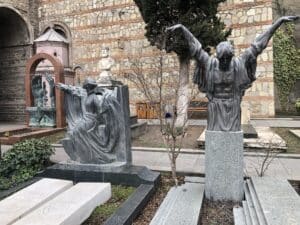
While not a museum, the Mtatsminda Pantheon is still an important and curated site that can teach you much about Georgian history, culture, and identity. This revered necropolis is where Georgia’s most notable writers, artists, and public figures are interred. Established in 1929, it sits by St. David’s Church on Mtatsminda. Here lies such greats of Georgian culture as Ilia Chavchavadze, Giorgi Leonidze, and Niko Pirosmani as well as ballerinas, military commanders, and academics.
.
History Museums
The National Museum (Simon Janashia Museum)
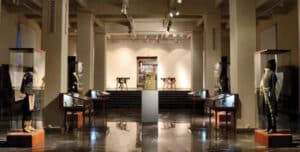
The National Museum, also known as the Simon Janashia Museum, is an excellent introduction to Georgia’s historical and cultural narrative. It showcases Georgia’s journey from prehistory through its interactions with great empires to the present day. The museum’s collection includes ancient jewelry, displays of Georgia’s flora and fauna, and a massive coin collection showing the different currencies that once flowed through Georgia from all over the region. There are also many medieval weapons used by Georgians during their Golden age as an independent empire. Lastly, there is a museum-within-the-museum, The Museum of the Soviet Occupation of Georgia, that focuses on the massive loss of culture and people that Georgia suffered in years just after the Soviets took over. Read a review of the museum on this site here.
Underground Printing House Museum of Joseph Stalin
Explore the building in which a young Joseph Stalin once secretly operated a revolutionary printing press in Tsarist Tbilisi. See this historic site where communist pamphlets were clandestinely printed, away from the watchful eyes of Russian authorities, and funded in part by Stalin’s bank heists. Today, the house has been converted to the headquarters of the modern Georgian Communist Party. The printing press, in the basement, is a private museum run by the party. Guided tours are available in Georgian or Russian.
Museum of the History of Jews in Georgia
Built where a synagogue once stood, The David Baazov Museum of the History of Jews in Georgia highlights the long-standing harmonious relationship between Georgian and Jewish communities through extensive exhibits. It explores their intertwined history from the 8th century BC to modern days, showcasing cultural exchanges and contributions of Georgian Jews across various fields. The exhibition delves into anthropological, social, and religious aspects, displaying artifacts, photographs, and art.
Museum of Repressed Writers
Opened in March 2023, this museum, housed in the Writers’ House of Georgia, examines the lives of writers under the Soviet regime and the interaction between creativity and repression. On display are the personal belongings and stories of many writers who were purged or driven to suicide by the regime. The museum’s exhibits, combining chronological storytelling with audio-visual aids, aim to honor these writers’ legacies and advocate for freedom of expression in the modern world.
The Tbilisi History Museum
Named after the poet Ioseb Grishashvili and housed in a 15th-century caravanserai, this museum showcases Tbilisi’s vibrant history. With over 50,000 artifacts ranging from the 4th millennium BCE to modern times, exhibits include archaeological finds, ethnographic items, art, and a significant photo collection. Visitors can also explore contemporary art exhibitions.
The Ilia Chavchavadze Literary-Memorial Museum
Located in his former residence, this museum offers insight into Ilia Chavchavadze’s massive influence on Georgian literature, politics, identity, and society. With a comprehensive collection including personal artifacts, documents, and exhibitions detailing his life and the broader historical context of Georgia, this museum documents the man that many consider to be modern Georgia’s “founding father.” Recently renovated, the museum integrates modern displays and educational programs, emphasizing Chavchavadze’s legacy in Georgia’s cultural and social development.
Technical and Trade Museums
The Museum of Holograms
This private museum showcases a variety of holographic representations of historical moments, theatrical sketches, and artworks by renowned artists such as Soliko Virsaladze and Lado Gudiashvili. The museum employs interactive and static exhibits that present art in a multidimensional and engaging way, allowing the visitor to step into a world where paintings and sketches come to life through holography.
The Georgian National Center of Manuscripts
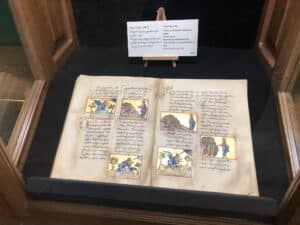
Established in 1958, The National Center of Manuscripts houses over 170,000 items spanning various languages and centuries, including Georgian, Greek, Hebrew, Armenian, and Arabic, among others, from the 1st to the 20th century. The center is dedicated to preserving, studying, and exhibiting these invaluable manuscripts, and showcasing Georgia’s rich literary and cultural heritage.
Tbilisi Wine Museum
The museum covers Georgia’s millennia-old history of winemaking and viticulture – from ancient and traditional practices through the modern age. Interactive exhibits showcase ancient qvevri vessels and historic artifacts. Immerse yourself in the flavors and aromas of Georgian wine with guided tastings, featuring a diverse array of indigenous grape varietals. Whether you’re a seasoned wine enthusiast or a curious novice, the Tbilisi Wine Museum promises an unforgettable journey through the vineyards of Georgia.
The Tbilisi Auto Museum
This museum is a bit off-the-beaten-path, but offers an impressive array of vintage cars – from the Soviet and pre-Soviet eras, all exquisitely restored. Ticket prices generally will include a tour with whoever is on staff. This is a private collection and often the owner himself is on hand to discuss the various cars, what went into restoring them, and the history of cars of in Georgia.
The State Silk Museum
Tbilisi was once an important center of silk production and study. This museum offers a look at sericulture, diverse silk artifacts, and the global impact of the silk trade. The museum presents a blend of scientific, cultural, and artistic perspectives on silk, making it an intriguing destination for those interested in history, science, and art alike. It’s an exceptional place to discover the legacy and evolution of one of Georgia’s prized industries.
The Museum of the History of Georgian Medicine
Georgia has been a learned society for millennia with deep and ancient connections to many other learned cultures. This is also reflected in the history of the country’s medicinal practices. Beginning with the legendary herbal remedies of Medea and Tbilisi’s sulfur bath treatments, visitors can explore over 19,000 items, including medical manuscripts, tools, and rare texts, spanning from ancient times to the 19th century. Highlighting traditional and folk medicines, the museum provides insights into Georgia’s medical evolution and serves as a resource for students and professionals alike, showcasing Georgia’s contribution to medical science.
Tea House Museum
Note that this isn’t really a museum – it’s a tea shop in a historic building with lots of old tea-related things around for décor. However, if you ask the people that work there about tea in Georgia, they will gladly tell you about it’s heyday under the Soviets, as the one place in the union where tea could be grown, to its near-death in 1990s, and its modern renaissance in independent Georgia. Make sure to ask which teas are grown in Georgia and what makes them special. They can also arrange tea tastings if you call in advance.


